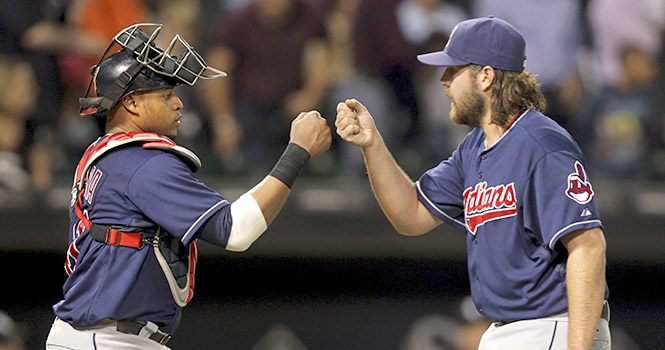A plan for the Cleveland Indians’ offseason
Cleveland Indians catcher Carlos Santana, left, congratulates relief pitcher Chris Perez after closing out the Chicago White Sox in the ninth inning at U.S. Cellular Field in Chicago, Illinois, on Wednesday, May 2, 2012. The Indians won, 6-3. (Chris Sweda/Chicago Tribune/MCT)
October 16, 2012
The arrival of Terry Francona means the Indians expect to contend in 2013 as opposed to rebuilding. Contending, though, means improving a roster that finished 68-94 in 2012.
There are many routes the Indians could take toward retooling, but here is how I see it: the Indians have about $35 million to spend, most of which will be used on raises for players already on the roster.
The Indians will have some money left for trades and free agents, but it will be nowhere near what a team like the New York Yankees has. There are holes throughout Cleveland’s roster, but three can be filled to make an immediate difference if the Tribe acquire some high-risk, high-reward players.
First, the Indians need to find a left fielder. A retread like Johnny Damon will not do next year; the Indians need an elite player like Melky Cabrera.
The risk with Cabrera is his suspension last year for using performance-enhancing drugs. Cabrera is likely still a great player, however, and the Indians should take his suspension as an opportunity to buy-low on a top-line outfielder.
Over the past two seasons, Indians left fielders have a .224 batting average, .619 on-base plus slugging (OPS), 18 home runs, and 25 steals, while Cabrera has a .322 batting average, .849 OPS, 29 home runs, and 33 steals. Cabrera is one of the best hitters in free agency and is a massive upgrade for the Indians.
A two-year, $12 million contract may be enough to sign the 28-year old switch-hitting Cabrera, as most teams seem to be interested in signing him to a one-year deal. Elite outfielders in their prime are rarely cheap enough for Cleveland to afford and the Indians should not let this one slip away.
The next step for the Indians is to trade Chris Perez, not because of his mouth, but because of his salary. The Indians can build an entire bullpen in 2013 for slightly more than what Perez alone will cost.
The San Francisco Giants were interested in Perez at the trading deadline and might still want him. If so, the Indians should convince the Giants to part with Brandon Belt, as San Francisco does not seem sold on him.
The Indians cannot pass up the opportunity to obtain a young, established first baseman, even if he hits left-handed. Belt’s .275 batting average and .781 OPS may not be eye-popping, but it far eclipsed the .240 batting average and .676 OPS of Cleveland first basemen in 2012.
Belt only hit seven home runs last year, but it is important to remember that he played his home games in AT&T Park. The Giants only hit 31 home runs all year at home and Belt had five of them.
Bringing Belt to Cleveland and freeing him from AT&T Park should allow his power to blossom and would give the Indians another young player ready to hit his prime.
Finally, it is no secret that Cleveland’s starting rotation was a mess last year. The Indians will need Justin Masterson and Ubaldo Jimenez to rebound to at least an average-level in order to contend, but the rotation still needs a No. 1 starter.
Enter Dan Haren. A bad back hampered the 32-year old Haren in 2012, but he is still a top-of-the-rotation starter. Only five pitchers have averaged 200 innings with an ERA lower than 3.60 over the past eight seasons: Roy Halladay, Felix Hernandez, C.C. Sabathia, Cliff Lee, and Haren.
Haren’s value will be down this offseason due to his subpar 2012, but that is precisely why the Indians should pounce on him now. A two-or three-year contract for $12 million a year could be enough to lure Haren to Cleveland and give the Indians a promising rotation in 2013.
The Indians can make the playoffs in 2013, but only if they take some risks. Signing Cabrera and Haren while trading for Belt would fill Cleveland’s biggest holes and might improve the roster enough to contend.
Contact Jim Piascik at [email protected].












